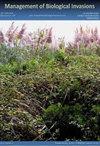米德湖国家休闲区水生入侵物种迁移的人为维度
IF 1.2
4区 环境科学与生态学
Q3 BIODIVERSITY CONSERVATION
引用次数: 0
摘要
自2007年1月在米德湖国家娱乐区发现斑蚌(Dreissena rostriformis bugensis)以来,国家公园管理局与众多机构和合作伙伴合作,通过检查和清除娱乐船只和划船教育计划来防止入侵物种的进一步传播。我们将地理和人口分析技术应用于在公园内的检查和净化站收集的数据,以及从美国西部的检查站收集的数据,以更好地了解游客划船的人数。利用ArcGIS ESRI Tapestry软件和在公园内检查船只的休闲划船者的家庭邮政编码,我们将本地和非本地划船者分为人口统计组,目的是制定更有针对性的教育计划。人口统计结果表明,在划船人口中有明显的趋势,包括:收入中位数较高,教育水平较高,船主的年龄中位数在35岁左右。米德湖船民人口统计的经济和行为模式,结合对环境运动设计中行为变化的现有研究的综合,表明需要有针对性的外展,以提高水生入侵物种(AIS)计划的有效性,并进一步降低AIS传播风险。本文章由计算机程序翻译,如有差异,请以英文原文为准。
Human dimensions of aquatic invasive species transport at Lake Mead National Recreation Area
Since the January 2007 discovery of quagga mussels ( Dreissena rostriformis bugensis ) at Lake Mead National Recreation Area, the National Park Service has worked with numerous agencies and partners to prevent further spread of invasive species through inspection and decontamination of recreational vessels and boater education programs. We applied geographic and demographic analysis techniques to data collected at inspection and decontamination stations within the park and data from inspection stations across the western United States to better understand the visitor boating population. Using ArcGIS ESRI Tapestry software and the home zip codes of recreational boaters whose vessels were inspected within the park, we classified local and non-local boaters into demographic groups with the goal of developing more targeted educational programs. Demographic results indicate distinctive trends within the boating population including: higher median incomes, high levels of education, and boat owner median ages in the mid-30s. Economic and behavioral patterns of Lake Mead boater demographics combined with a synthesis of available research on behavior change in environmental campaign design demonstrate the need for targeted outreach to increase the effectiveness of aquatic invasive species (AIS) programs and further reduce AIS transmission risk.
求助全文
通过发布文献求助,成功后即可免费获取论文全文。
去求助
来源期刊

Management of Biological Invasions
Agricultural and Biological Sciences-Ecology, Evolution, Behavior and Systematics
CiteScore
3.40
自引率
6.70%
发文量
21
审稿时长
16 weeks
期刊介绍:
Management of Biological Invasions, established in 2010 by Dr. Elias Dana, is an open access, peer-reviewed international journal focusing on applied research in biological invasions in aquatic and terrestrial ecosystems from around the world. This journal is devoted to bridging the gap between scientific research and the use of science in decision-making, regulation and management in the area of invasive species introduction and biodiversity conservation.
Managing biological invasions is a crisis science, with Management of Biological Invasions aiming to provide insights to the issues, to document new forms of detection, measurements and analysis, and to document tangible solutions to this problem.
In addition to original research on applied issues, Management of Biological Invasions publishes technical reports on new management technologies of invasive species and also the proceedings of relevant international meetings. As a platform to encourage informed discussion on matters of national and international importance, we publish viewpoint papers that highlight emerging issues, showcase initiatives, and present opinions of leading researchers.
 求助内容:
求助内容: 应助结果提醒方式:
应助结果提醒方式:


